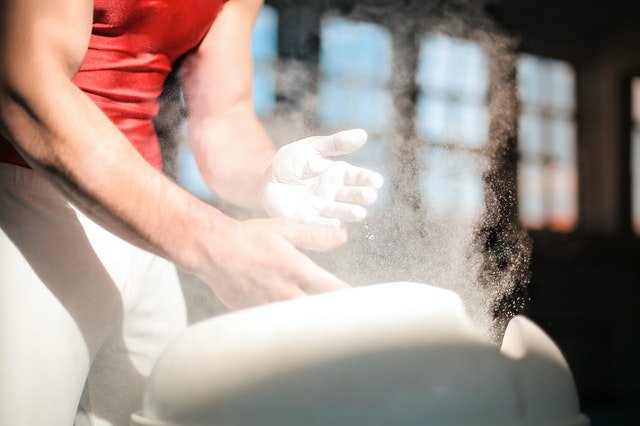
Magnesia carbonica is a homeopathic remedy of a mineral nature, obtained from magnesium carbonate, which is prepared artificially by decomposing magnesium sulfate, dissolved in water, by means of a solution of potassium carbonate or sodium.
The remedy was experimented by Hahnemann and is now used for the treatment of numerous ailments including gastritis.
Magnesium carbonate in sport
Magnesium carbonate is a chemical compound with the formula MgCO3 and occurs naturally in the form of a white mineral. In its powder formulation it is widely used as an antiperspirant in many sports.
As just mentioned, magnesium carbonate is used as an antiperspirant in many sports in order to dry sweat and therefore allow a firmer and safer grip on the tools. Think for example of the rings, the bar, the horse or the horse with handles, as perhaps many times you have seen it used in artistic gymnastics, both by athletes at the Olympic Games and even in schools.
Magnesium carbonate is also used in climbing, to allow you to keep the grip of the hand pressing and useful with respect to the specific hook or the specific rock spike to which you have turned.
Magnesia carbonica: homeopathic remedy
The homeopathic preparation of Magnesia carbonica is obtained by shredding magnesium carbonate.
It is an indicated remedy: in acute and chronic cases; in newborns; in children; in women; in asthenic, lean, cold subjects, with secretions and excretions of bad smell, suffering from headache and neuralgia mainly nocturnal, acid dyspepsia and sleep disorders.
It is mainly used for the following ailments:
- Nervous system: neuralgia, sensory hyperesthesia and sensitivity disorders
- Muscle: spasms, cramps, muscle hypotonia and tremors
- Circulatory system: slowing of venous circulation, hepatic and pelvic stasis, lowering of blood pressure
- Blood: hemolytic phenomena with anemia
- Gastrointestinal mucous membranes: irritative phenomena resulting in acidic diarrhea
- Skin: dryness, dystrophy, itching and acid sweating; fragility of nails and hair due to atrophy of the pilo-sebaceous apparatus
Magnesia carbonica and gastritis
- acute gastritis: manifests itself as a result of the continued use of pain-relieving and anti-inflammatory drugs (NSAIDs – nonsteroidal anti-inflammatory drugs) such as aspirin. Other triggers are smoking, alcohol, food abuse, the use of spices and irritants, systemic bacterial or viral infections (eg cytomegalovirus, salmonella), intense stress, trauma, burns, surgery. Once the cause is removed, acute gastritis typically resolves spontaneously.
- chronic gastritis: it is the form that has the most consequences because it is the result of the continuous presence over time of irritating factors. It presents with symptoms such as nausea, belching, swelling, weight in the epigastric region, vomiting. Sometimes fever and headache are also present.
One of the most important risk factors for the development of gastritis is infection by a bacterium, Helicobacter Pylori (Hp). But there are a whole series of factors, environmental and psychological that cause the pathology: alcohol, smoking, physical and psychological stress. In fact, not to be underestimated is also the psychic component of the disorder, often in fact The burning and gastric pain express the difficulty in manifesting oneself fully, retaining all the accumulated tension inside.
Usually those who suffer from gastritis are a very anxious person who presents forms of addiction derived not from a real need but from the feeling of not having permission to become autonomous.
The homeopathic remedy Magnesia carbonica is useful when gastric burning, cramps are present and when gastritis is manifested by marked hyperacidity and intestinal disorders (more frequently diarrhea).
Magnesia carbonica: constitutional type

The patient Magnesia carbonica strongly fears abandonment, does not tolerate conflicts, is anxious and irritable. It tends to hypochondria, depression and reacts with anger, anger or anger even to stimuli and situations of little entity.
He is often grumpy and in a bad mood, has difficulty establishing authentic interpersonal relationships and tends to reject company.
Here are its clinical features:
General symptoms
The following disorders are part of the general constitutional symptoms of this type: developmental blockage, colic, constipation, hepatitis, pregnancy, insomnia, neuralgia, chronic fatigue syndrome, premenstrual syndrome.
Local Symptoms
- Head: trigeminal neuralgia (left side)
- Gastrointestinal: slow digestion, constipation, diarrhea after milk, abdominal colic, milk intolerance, hepatitis
- Urogenital: menstrual flow that arises at night and stops during the day
Mental Symptoms
The subject in question presents anxiety during the day that improves in the evening in bed, also does not tolerate quarrels, presents anxieties with tremors, exhaustion in the morning upon waking up and insomnia around 3 am.
The subject Magnesia carbonica has a strong desire for meat, bread and butter, vegetables and an aversion to fruit. Its symptoms worsen with drafts, before menstruation, with hot foods, at 3 am or from 3 to 4 am. Instead, they improve with local heat and pressure.






